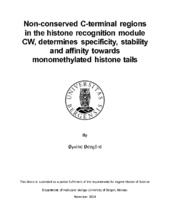Non-conserved C-terminal regions in the histone recognition module CW, determines specificity, stability and affinity towards monomethylated histone tails
Master thesis
Permanent lenke
https://hdl.handle.net/1956/11686Utgivelsesdato
2014-11-20Metadata
Vis full innførselSamlinger
Sammendrag
Histone modifications have an important role in epigenetic gene regulation and contribute to the cellular memory system. It has been well documented that certain patterns of histone modifications are associated with different states of gene expression. The mechanisms underlying these associations are, however, still poorly understood. Many nuclear proteins have histone recognition modules that can serve to recruit the proteins to relevant sites in chromatin. The CW domain is a family of histone recognition modules found in chromatin-related proteins. While all known CW domains have specificity for histone H3 methylated on lysine 4, different subfamilies of CW domains have different specificities for different methylation states. The C-terminal lid regions" of the CW domains are highly variable and they have been proposed to contribute to the ligand specificity. To explore how the C-terminal "lid regions" contribute to ligand specificity, this project aims to measure the relative mobility of these regions in A. thaliana ASHH2 CW domain using NMR experiments. To support our claims, intrinsic tryptophan fluorescence thermal denaturation and ITC have been used. We have engineered three ASHH2 CW domain variants, which differ in length in their N- and C-terminal regions. We show that the lid regions are important for the stability of the domain, and that the protein adopts a more stable confirmation upon ligand binding. The C-terminal helix is mobile in the unbound state but becomes less mobile upon binding. We also show that K9 has a small effect on binding since doubly modified H3K4me1K9ac has a higher KD than H3K4me1. Furthermore, the implications for the binding mechanisms are discussed.
